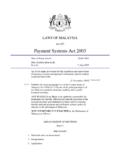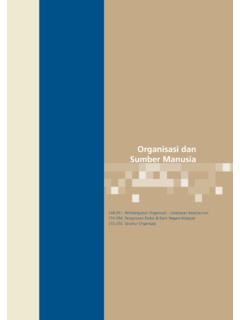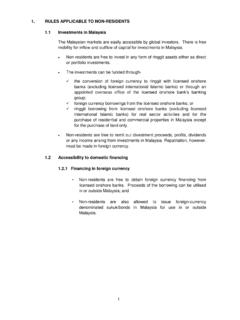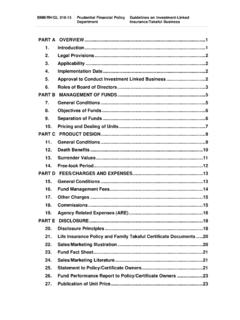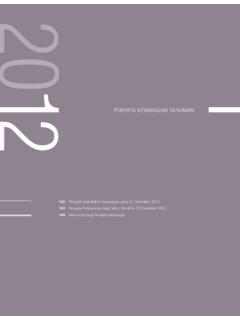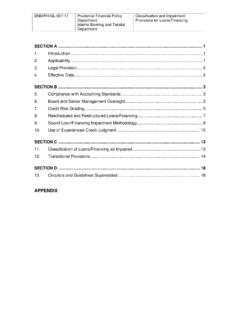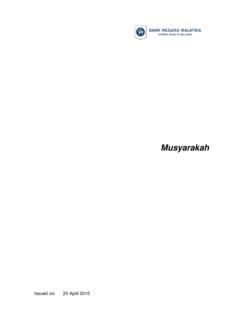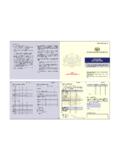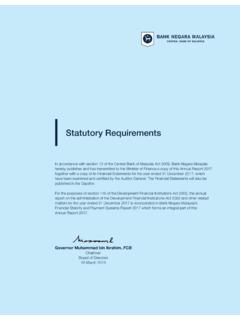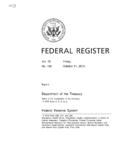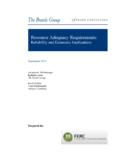Transcription of Capital Adequacy Framework (Capital Components)
1 Capital Adequacy Framework ( Capital Components). Applicable to: 1. Licensed banks 2. Licensed investment banks 3. Financial holding companies Issued on: 13 October 2015 BNM/RH/PD 032-4. Capital Adequacy Framework ( Capital Components). TABLE OF CONTENTS. PART A OVERVIEW .. 1. 1 1. 2 Applicability .. 1. 3 Legal provisions .. 1. 4 Effective 1. 5 Interpretation .. 2. 6 Policy document superseded .. 2. PART B GENERAL REQUIREMENTS .. 3. 7 Level of application .. 3. 8 Capital Adequacy ratios .. 4. 9 Minimum Capital Adequacy requirements .. 5. 10 Capital buffer requirements .. 5. PART C COMPONENTS OF Capital .. 8. 11 Common Equity Tier 1 8. 12 Additional Tier 1 Capital .. 8. 13 Tier 2 Capital .. 9. PART D CRITERIA FOR INCLUSION IN Capital .
2 10. 14 Ordinary shares .. 10. 15 Additional Tier 1 Capital instruments .. 11. 16 Tier 2 Capital instruments .. 14. 17 Minority interest and Capital instruments issued out of consolidated subsidiaries and held by third parties .. 16. PART E REGULATORY ADJUSTMENTS .. 20. 18 Goodwill and other intangibles .. 20. 19 Deferred tax assets and liabilities .. 20. 20 Property revaluation 20. 21 Cumulative gains/losses of financial instruments classified as available- for-sale or designated at fair value .. 21. 22 Cash flow hedge reserve .. 21. 23 Regulatory reserve for loans/financing .. 21. 24 Shortfall of eligible provisions to expected losses .. 22. 25 Valuation adjustments .. 22. 26 Increases in equity Capital resulting from a securitisation transaction.
3 22. 27 Cumulative gains/losses due to changes in own credit risk on fair valued liabilities .. 22. 28 Defined benefit pension fund assets and liabilities .. 22. 29 Investments in own Capital instruments .. 23. 30 Investments in the Capital of unconsolidated financial and insurance/. takaful entities .. 24. 31 Other regulatory adjustments .. 26. Issued on: 13 October 2015. Capital Adequacy Framework ( Capital Components). PART F OTHER REQUIREMENTS .. 27. 32 Requirements to ensure loss absorbency at the point of non-viability .. 27. 33 Write-off or conversion mechanisms for achieving principal loss absorption and/or loss absorbency at the point of non-viability .. 28. 34 Disclosure requirements.
4 30. 35 Regulatory process and submission requirements .. 30. 36 Statistical reporting requirements .. 32. PART G TRANSITIONAL ARRANGEMENTS .. 33. 37 Transitional arrangements for banking institutions .. 33. APPENDICES .. 37. APPENDIX 1 General treatment of equity investments .. 37. APPENDIX 2 Illustration of minority interest and Capital instruments issued out of consolidated subsidiaries held by third parties .. 38. APPENDIX 3 Transitional arrangements for Capital instruments .. 41. APPENDIX 4 Illustration of the gradual phase-out 43. APPENDIX 5 Write-off mechanisms for Tier 2 Capital instruments structured using exchange-based contracts .. 45. Issued on: 13 October 2015. Capital Adequacy Framework ( Capital Components) 1 of 45.
5 PART A OVERVIEW. 1 Introduction Regulatory Capital requirements seek to ensure that risk exposures of a financial institution are backed by an adequate amount of high quality Capital which absorbs losses on a going concern basis. This ensures the continuing ability of a financial institution to meet its obligations as they fall due while also maintaining the confidence of customers, depositors, creditors and other stakeholders in their dealings with the institution. Capital requirements also seek to further protect depositors and other senior creditors in a gone concern situation by promoting an additional cushion of assets that may be used to meet claims in liquidation. Policy objective The Capital Adequacy Framework sets out the approach for computing regulatory Capital Adequacy ratios, as well as the levels of those ratios at which a financial institution is required to operate.
6 The Framework has been developed based on internationally-agreed standards on Capital Adequacy promulgated by the Basel Committee on Banking Supervision (BCBS). Scope of policy This policy document sets out the general requirements concerning regulatory Capital Adequacy , and the components of eligible regulatory Capital . It shall be read together with the Capital Adequacy Framework (Basel II Risk-Weighted Assets) which details out the requirements for computing risk-weighted assets. 2 Applicability This policy document is applicable to all financial institutions as defined in paragraph 3 Legal provisions This policy document is specified pursuant to section 47 (2), section 51, section 115, section 143 (2), and section 266 of the Financial Services Act 2013 (FSA).
7 4 Effective date This policy document comes into effect . (a) on 1 January 2016 for a banking institution, subject to the transition arrangements set out in Part G; and (b) on 1 January 2019 for a financial holding company. Issued on: 13 October 2015. Capital Adequacy Framework ( Capital Components) 2 of 45. 5 Interpretation The terms and expression used in this policy document shall have the same meanings assigned to them in the FSA, unless otherwise defined in this policy document. For the purpose of this policy document . S denotes a standard, an obligation, a requirement, specification, direction, condition and any interpretative, supplemental and transitional provisions that must be complied with.
8 Non-compliance may result in enforcement actions;. G denotes guidance which may consist of statements or information intended to promote common understanding and advice or recommendations that are encouraged to be adopted;. banking institution means a licensed bank or a licensed investment bank, as the case may be;. financial group refers to a licensed bank and its subsidiaries, a licensed investment bank and its subsidiaries, or a financial holding company and its subsidiaries, as the case may be;. financial holding company refers to a financial holding company approved pursuant to section 112(3) of the FSA and holds investment directly or indirectly in corporations that are engaged predominantly in banking business.
9 Financial institution means a banking institution or financial holding company, as the case may be;. financial subsidiary refers to any entity, whether incorporated in or outside Malaysia, engaged substantively in, or acquiring holdings in other entities engaged substantively in, any of the following activities: banking, provision of credit, securities broking, fund management, asset management, leasing and factoring and similar activities that are ancillary to the conduct of these activities. 6 Policy document superseded This policy document supersedes the policy document on Capital Adequacy Framework ( Capital Components) issued on 28 November 2012. Issued on: 13 October 2015. Capital Adequacy Framework ( Capital Components) 3 of 45.
10 PART B GENERAL REQUIREMENTS. 7 Level of application S A banking institution shall comply with the Capital Adequacy requirements in this policy document at the following levels: (a) entity level1, referring to the global operations of the banking institution ( including its overseas branch operations) on a stand-alone basis, and including its Labuan banking subsidiary; and (b) consolidated level, which includes entities covered under the entity level requirement, and the consolidation 2 of all financial and non-financial subsidiaries, except insurance/takaful subsidiaries which shall be deducted in the calculation of Common Equity Tier 1 Capital3. S A financial holding company shall comply with the Capital Adequacy requirements in this policy document at the consolidated level in accordance with paragraph (b).
